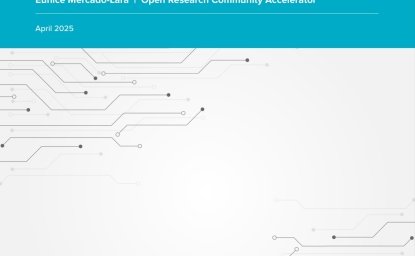Introduction
The United States' scientific leadership is in question, particularly when compared to countries like China which exceeds the US in total R&D expenditure. Scientific leadership is beneficial for national security, economic growth, and stability, developing global ethics and standards. Given the need for a robust innovation and research system in the United States, many experts are questioning why we are not keeping apace.
Part of this could be that the underpinning policies informing the US innovation system date back to World War II. During World War II, the Office of Scientific Research and Development (OSRD), led by Vannevar Bush, used federal funding to coordinate scientific research for the war effort. As a part of this, Bush wrote a report entitled “Science, the Endless Frontier” which became “the blueprint for post war science in America” per a 2015 National Bureau of Economic Research report.
The model was designed to be simple. As described in Issues in Science and Technology, Bush assumed a linear model of innovation. In this model, the federal government funds university researchers who generate knowledge by performing ‘basic’ research. Industry then takes that research to turn it into products. This model has become known as the Triple Helix Model, as it combines three key stakeholders woven together to create the ‘DNA’ of scientific innovation and are key to innovation in a knowledge-based economy: universities, government, and industry.
But this is not 1945. Even twenty years ago, Henry Etzkowiz and Loet Leydesdorff argued that “...the sources of innovation in a Triple Helix configuration are no longer synchronized a priori. They do not fit together in a pregiven order, but they generate puzzles for participants, analysts, and policymakers to solve.” Here, we will explore the changes that have taken place in the key partners of the Triple Helix Model and highlight ways to update our innovation models today.
University
In the Triple Helix model, universities are at the core of research but in order to understand why they are so foundational, it’s important to put them in context. Part of that is the ways that universities have evolved. In the book The Triple Helix, Etzkowitz describes their evolution in terms of two academic revolutions. The first academic revolution began with the creation of the research university in Prussia, which transformed universities from transmitters and preservers of knowledge to producers of knowledge. The shift resulted in many universities going from merely teaching students to focusing on research outputs. Some of this is still true. For example, today, the National Center for Science and Engineering Statistics demonstrates that since the 1960s, academia performs over 40% of basic research in the United States, making them a primary source for research. Their role in the science and technology system is providing and maintaining scientific knowledge and educating people who are able to utilize and improve that body of knowledge.
Yet compounding this issue is that universities have undergone a second revolution more recently, one financially motived. The second academic revolution started with the rise of entrepreneurial universities in the United States that sought to capitalize on the production of knowledge. Universities, as teaching institutions, have always had economic and social development benefits but the entrepreneurial university connects those benefits to its research mission. Complicating this further, advancing research now often requires international investments in large collaborative projects, such as the search for the Higgs Boson and the Ocean Discovery Program.
There are other evolutions to the university that reflect this international focus. To begin with, the United States has become increasingly dependent on international STEM students, who outnumber American graduate students, while foreign-born individuals make up 43% of STEM workers at the PhD level. As National Academy of Sciences president Dr. Marcia McNutt argued at the State of the Science Address, other nations invest in K-12 education for their students, and “we steal them to come here because we aren’t training our own students well enough.”
Government
Before World War II, federal support for research, whether basic or applied, was almost nonexistent. During the war, the scientific research war machine developed technologies such as radar and the atomic bomb that were crucial to the allied victory.
These research efforts were coordinated through the aforementioned OSRD. As Director of OSRD in 1945, Bush’s “Science, the Endless Frontier” was a catalyst for science policy conversations, leading to the creation of several civilian and defense research agencies were created which gave grants to universities and researchers, including the Office of Naval Research and the Atomic Energy Commission which later evolved into the Department of Energy. It also led to the creation of the National Science Foundation (NSF) in 1950, a notable instrument for federal funding in scientific endeavors.
Much in line with the model Bush originally proposed, the NSF now has a directorate for Technology, Innovation, and Partnerships that facilitates collaboration between the spheres of university and industry to take technologies from lab to market. It involves coordinating resources and mediating university-industry interactions. This new directorate is one example of how the government’s role in the Triple Helix goes beyond simply funding basic research to creating an enabling environment for research to occur.
Yet some experts are concerned that federal funding has also not always been equitable to the potential detriment of our domestic research workforce. In the same address as above, McNutt argued for more efforts to increase the pipeline of a strong domestic scientific workforce, particularly citing declining federal funding for HBCUs and other minority serving institutions. There have been recent moves to correct this and directly serve minority institutions, but the concern is that innovation cannot fully happen until we have the widest demographic of participating research institutions involved.
Industry
At the time of Bush’s report, the federal government was the primary research funder. Now, industry dominates R&D in the United States. Industry R&D investment surpassed federal investment in 1981 and has continued to increase since then. Philanthropy has also become an important support for basic research through foundations, nonprofits, and university endowments.
Richard Nelson, in his book National Innovation Systems, suggests that prior to 1900, US industrial innovation “did not rely heavily on scientific research.” Rather, Nelson argues that industrial research was used to “retain power without running afoul of antitrust law.” As US research universities became more successful, industrial and academic research developed in parallel with linkages influenced by decentralized structure and funding of US higher education. Per an article in Industrial and Corporate Change, the end of the World War II gave way to the “emergence of closed, vertically integrated, large corporate R&D labs (IBM, GE, Dupont, Bell labs) and the adoption of a linear approach to R&D where in-house science was preferred to external IP licensing,” but this structure changed again after the 1980s. Private firms could simply outsource their R&D and had little incentive to invest in long-term basic research in-house.
A 2001 NIST report shows that there is a “valley of death” between the publicly funded, basic R&D that happens at universities and the industrial R&D that results in product development. Data from NCSES show that the business sector performs 63% of applied research and 92% of experimental development. Businesses aim to make profit, and so they fund applied research that can be directly connected to market outcomes.
Helical Links
The lines between the institutional spheres of university, government and industry are more blurred than they might first appear. As argued by others cited throughout this piece, the way our system works is less of a linear progression and more of a series of back and forth that looks less like a line and more like helical links.
For example, tracing the development of technologies that make the iphone so ‘smart’, Dr. Marianna Mazzucato found a variety of government funded mission agency and university research programs that did not directly feed into industry (e.g. Apple, Inc.). Department of Energy and the Defense Advanced Research Projects Agency research programs created the micro hard drive. The National Science Foundation, National Institutes of Health, and Department of Defense sponsored research led to the development of liquid crystal displays. The Hypertext Transfer Protocol and web development language HTML, the bases of the world wide web, were developed at CERN, an institute dedicated to the most fundamental research at the heart of modern physics. Per an article in Issues: “finding the right language to explain to the public how scientific discoveries make their way to applications and markets remains a work in progress.”
This is not the vision of Bush back in the 1940s. The framework of the original report from Bush does not fully account for the helical links between the institutions of university, industry and government, yet it still guides policy today. Institutional interactions between university industry and government have changed since World War II, while the national policy blueprint that governs them has not.
Authors




Science and Technology Innovation Program
The Science and Technology Innovation Program (STIP) serves as the bridge between technologists, policymakers, industry, and global stakeholders. Read more

Explore More
Browse Insights & Analysis
360° View of How Southeast Asia Can Attract More FDI in Chips and AI



